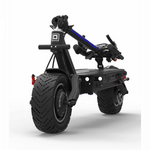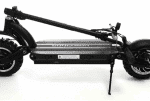Table of Contents
Prioritizing Safety on Adult Electric Scooters
Riding adult electric scooters offers a blend of fun and practicality in commuting. Nonetheless, safety should always take center stage. Above all, always don a helmet. With head injuries posing potentially the gravest risks, safeguarding your cranium becomes imperative. Alongside helmets, gear up with knee and elbow protectors and sport closed-toe shoes. These shields you further in the event of mishaps. Adherence to traffic norms is essential: follow signals, gesture your turns using hand indications, and opt for bike lanes where available. Stay vigilant of your environment and preempt the possible moves of fellow road users. Regular scooter check-ups encompassing brakes, tires, and lighting systems are also key. Embracing these safety guidelines allows you to maximize the advantages of riding an adult electric scooter while mitigating accident risks.
Understanding Electric Scooters: The Basics
Electric scooters are compact, motor-driven vehicles tailored for individual mobility. They typically feature a standing platform, steering handlebars, and an electric propulsion system. Fueled by a rechargeable battery, the electric motor propels the scooter. Their rising popularity stems from their green footprint and user-friendliness. To navigate, riders stand on the platform, hold the handlebars, and initiate motion with a foot push. The onboard electric motor augments this momentum, facilitating travel over longer stretches with minimal effort. Most electric scooters clock speeds in the 15-20 mph range and offer a travel span of 10-20 miles per charge. In essence, they serve as an optimal solution for short commutes without reliance on fuel or exhaustive exertion.
Decoding Electric Scooter Operation
Varieties of Electric Scooters Explained: At its core, an electric scooter’s thrust comes from its electric motor, drawing energy from its battery reservoir. These batteries typically employ lithium-ion cells, akin to those in contemporary gadgets like smartphones and laptops. Upon ignition, the battery directs electricity to the motor, transforming this electric input into kinetic drive, propelling the scooter. The battery’s energy quantum dictates the scooter’s speed and range capabilities. Speed modulation is through a throttle, usually located on the handlebars. Manipulating the throttle alters the electric feed to the motor, dictating the scooter’s pace. The brakes are equally advanced, being electronically actuated via a handlebar lever. Engaging this lever signals the motor to decelerate or halt, ensuring responsive and fluid braking. In summation, electric scooters amalgamate electric motor potency with battery capabilities, offering a sustainable and streamlined transport mode.
Advantages of Opting for an Electric Scooter
Riding electric scooters presents a plethora of benefits. At the forefront, they champion an eco-conscious cause by producing zero emissions, fostering cleaner air and a healthier environment. From an economic perspective, they prove to be cost-efficient. When juxtaposed with cars or motorcycles, they boast lower operating expenses, demand minimal maintenance, and the electricity required for charging pales in comparison to conventional fuel costs. Their compact and lightweight nature underscores their convenience, facilitating easy navigation through congested areas and simplifying parking. Beyond functionality, their ride is synonymous with silence and smoothness, making journeys pleasant. In summary, electric scooters are a contemporary nod to efficient, economical, and green transportation.
Legal Considerations for Electric Scooter Enthusiasts
Navigating the legal landscape for electric scooter operation can be intricate, given that regulations often vary across regions. Many jurisdictions mandate an age threshold, usually 16 or 18, for legal scooter operation. Depending on the scooter’s speed and class, a valid driving license or permit might also be a prerequisite. Safety protocols generally entail helmet usage and adherence to standard traffic conventions akin to those for cyclists and motorists, including obeying signals, using designated lanes, and signaling intentions. Some locales may also dictate where scooters can tread, sometimes barring sidewalk use. Riders are urged to acquaint themselves with local directives to ensure seamless, legal riding experiences.
Finding Your Perfect Electric Scooter
When on the hunt for an ideal electric scooter, deliberate upon your primary purpose. City commutes might steer you towards nimble, compact variants, whereas rugged terrains or lengthier travels demand robust batteries, potent motors, and larger wheelbases. Evaluate the scooter’s weight and height thresholds to ascertain if they align with your physique. Key metrics, like the scooter’s load-bearing capacity and travel range per charge, warrant attention. Lastly, budget considerations can guide you toward models that encapsulate essential features without breaking the bank.
Key Elements to Assess in Electric Scooters
Perusing electric scooters necessitates examining quintessential features that enhance the riding experience. Parameters like top speed and travel range should be pivotal in your assessment. Equally significant is the evaluation of battery prowess in terms of capacity and recharge duration. For those with mobility and storage concerns, a featherweight, foldable scooter might be appealing. Safety, often understated, hinges on a formidable braking mechanism. Supplementary features, including shock mitigators, LED illuminators, and ergonomic design, can further refine the ride. The quest should be for a scooter that harmoniously melds these attributes, tailored to individual desires and necessities.
Leading Electric Scooter Brands in the Spotlight
The electric scooter domain boasts formidable brands known for their craftsmanship and innovation. Xiaomi emerges as a frontrunner, revered for its fusion of aesthetic finesse and potent drive systems, catering to diverse pockets. Segway’s offerings, fortified by trailblazing tech and robust builds, have garnered commendations for reliability. Razor, an established name in scooter lore, entices with its economically priced, user-centric electric models. For those with a green bent, Zero’s offerings, rooted in sustainability and carbon footprint minimization, are enticing. Making an informed choice involves juxtaposing these brands based on individual preferences.
Deciphering the Ideal Speed and Range of Electric Scooters
An electric scooter’s quintessential speed typically orbits between 15-20 mph, striking a delicate balance between brisk commutes and ensuring rider safety. A single charge range enveloping 20-30 miles is generally perceived as optimal, enabling everyday commutes and errand runs without incessant battery anxiety. However, it’s paramount to remember that these metrics aren’t set in stone; they hinge on individual preferences and riding intentions. Battery stamina and motor prowess can also skew these ideals. Hence, tailoring these parameters to align with your use case is the best route to take.
Commuting on an Electric Scooter: Things to Ponder
Commuting on electric scooters ushers in certain considerations. Foremost, they aren’t marathon runners; their battery life has limits. Route optimization, thus, becomes key. Equip your scooter with a phone holder to facilitate seamless navigation. Remember, these scooters aren’t pack mules; respect their weight capacities to ensure safe and efficient rides. Safety can’t be stressed enough — helmets, knee guards, and reflective wear should be staples. Before diving into bustling traffic, get acquainted with your scooter’s pace and controls in less frenetic settings. Also, familiarize yourself with the local legal tape surrounding electric scooter usage.
Navigating Electric Scooter Weight Capacities
Electric scooter weight capacities oscillate based on their build and brand. The general ballpark figures hover around 220 pounds (100 kilograms). However, beefier variants catering to the more substantial populace can support between 250-330 pounds (113-150 kilograms). Scour the manufacturer’s playbook before purchasing to prevent compatibility issues. Overloading can not only hamper the ride but also strain the scooter components and battery. Those teetering on the weight ceilings should gravitate towards heavy-duty variants.
The ABCs of Electric Scooter Maintenance & Operation
Electric scooters, in their simplicity, outshine their gasoline-driven counterparts in maintenance. Your checklist should revolve around tire pressure vigilance, brake pad health checks, and diligent battery charging. Under or over-inflated tires can be Achilles’ heels, while worn brake pads scream for replacements. Scooter operation mandates control familiarity — the brake, accelerator, and horn. Stay updated with the road rulebook and always champion safety, be it via helmets or pedestrian courtesy.
Charging Rituals for Your Electric Scooter’s Battery
Charging your electric scooter’s battery demands some rituals. Always stick to the brand-specific charger; improvisations can lead to battery woes. Power down your scooter before initiating the charge to avert any electric anomalies. Upon identifying the charging port, ensure a snug charger connection for uninterrupted charging. Adhering to the user manual’s charging timeline is paramount; overcharging can compromise battery longevity. Regularly monitoring the charging trajectory via battery indicators can be insightful. Post-charge, always cap the charging port to shield it from external elements. Diligence in battery charging ensures you extract the maximum juice out of your electric scooter.
What are the benefits of using electric scooters for commuting?
Electric scooters have emerged as a popular mode of transportation for many urban commuters due to their numerous benefits. Firstly, they provide a quick and efficient means of traveling short distances without the hassles associated with driving or parking a car. They are compact and lightweight, making them easy to maneuver through congested city streets. Electric scooters also produce zero emissions, making them environmentally friendly and contributing to reduced air pollution. Moreover, they can be a cost-effective transportation alternative. When compared to car ownership or regular use of taxis or rideshare services, electric scooters often result in lower expenses over time. They also offer flexibility, as riders can easily integrate them with other modes of transportation, such as buses or trains. Additionally, electric scooters can contribute to reduced traffic congestion and demand for parking spaces, which can benefit urban infrastructure. Overall, electric scooters provide an accessible, eco-friendly, and efficient way to commute in urban settings.
How do electric scooters compare to traditional bicycles for commuting?
Both electric scooters and traditional bicycles offer unique advantages for commuting, and the best choice often depends on individual preferences and specific commuting needs. Here are some comparative insights:
- Speed and Efficiency: Electric scooters generally offer consistent speeds and require less physical effort than traditional bicycles, especially over hilly terrains or long distances. This can be beneficial for those who don’t want to arrive at their destination sweaty or exhausted.
- Portability and Storage: Electric scooters are generally more compact and can be folded, making them easier to carry into buildings or onto public transportation. Bicycles, unless they are foldable, typically require bike racks or dedicated parking areas.
- Range: While electric scooters have a limited battery range, traditional bicycles can be ridden indefinitely as long as the rider has the stamina.
- Exercise: Bicycles offer the added benefit of physical exercise, which can be a crucial factor for those looking to incorporate fitness into their daily routine.
- Cost: The initial investment for an electric scooter can be higher than a basic bicycle. However, the running costs of an electric scooter can be lower due to the absence of costs like chain lubrication or tire replacements that bicycles might need more frequently.
- Environmental Impact: Both electric scooters and bicycles have a lower environmental impact than cars, but bicycles have an edge since they don’t require electricity to operate.
- Safety: Bicycles, being larger, might be more visible on the road than electric scooters. However, both require the rider to take safety precautions, such as wearing helmets and reflective gear.
In conclusion, the choice between an electric scooter and a traditional bicycle boils down to personal preference, the specific needs of the commute, and the importance of factors like exercise, speed, and convenience.
What is the average battery life of an electric scooter?
The battery life of an electric scooter largely depends on factors like its capacity, terrain, rider weight, and overall usage pattern. On average, most electric scooters can travel between 10 to 40 miles on a single charge. High-end models might offer even longer ranges. Over time, like all rechargeable batteries, the battery’s capacity may decrease, which means the distance it can cover on a full charge might reduce gradually. It’s essential to follow the manufacturer’s guidelines for charging and storing the scooter to maximize battery longevity.
Can electric scooters be used in rainy conditions?
While some electric scooters are designed to be water-resistant, they are not entirely waterproof. Riding in light rain might be acceptable for some models, but it’s generally advised against using electric scooters in heavy rain or waterlogged conditions. Wet conditions can pose a risk both in terms of safety (e.g., slippery surfaces) and potential damage to the scooter’s electrical components. Before using an electric scooter in rainy conditions, it’s important to check the manufacturer’s guidelines and ensure the scooter is equipped for such conditions.
How do I choose the best electric scooter for my needs?
When choosing an electric scooter, consider the following factors:
- Range: Determine how far you typically need to travel on a single charge.
- Weight Capacity: Ensure the scooter can comfortably support your weight.
- Portability: If you need to carry it often, look for foldable and lightweight models.
- Terrain: If you’ll be riding in hilly areas, choose a scooter with a powerful motor.
- Safety Features: Look for features like efficient braking systems, lights, and reflectors.
- Battery Life: Check how long the battery lasts and how long it takes to recharge.
- Price: Determine your budget and find a scooter that offers the best features within that range.
- Reviews and Recommendations: Read user reviews and seek recommendations to ensure the scooter’s quality and performance.
Ultimately, your choice should be a balance between your commuting needs, the scooter’s features, and your budget.


